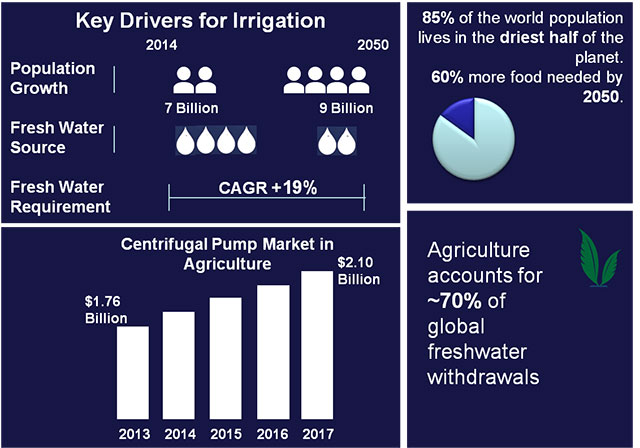Agriculture is a dominant industry worldwide. Demand for agricultural products is expected to steadily build as populations continue to grow, primarily in regions such as Asia and Latin America. Meanwhile, North America is regaining its dominant export position, and Africa and Asia are expected to increase net imports to meet demands.
Pumps play a critical role in agricultural businesses, especially for areas with uneven rain patterns and water scarcity (see Figure 1). Fluctuations in groundwater levels have led to further development of the pump market and rising demand. Several equipment industries, including pumps and related products, are heavily involved during the design of a farm-based irrigation network.
 Figure 1. Global water scarcity and rising food demands drive the irrigation pumps market. (Courtesy of Frost & Sullivan)
Figure 1. Global water scarcity and rising food demands drive the irrigation pumps market. (Courtesy of Frost & Sullivan)Crop prices are expected to decrease further during the next one to two years before they stabilize, making remaining profitable difficult for farmers. Water and energy use directly influence most farms’ bottom line. Irrigation ensures the required supply of water to produce enough quality crops and maintain profitability. With proper experience and planning, an efficient irrigation system is the key to a successful farm business.
Technology Trends
Irrigation involves three main water applications: sourcing, treatment and distribution. For water sourcing, pumps can be surface, submersible or floating pumps. Surface pumps are less expensive than submersible pumps and can be used in applications involving water distribution, but surface pumps are not as effective as submersible for suction.
Irrigation systems must be planned based on requirements and applications, integrating pumps at each stage. Planning pump configuration ensures that the system does not consume more energy than it requires. Often, the irrigation area is large, and multiple motors may be present across the farm. Other challenges in developing countries include erratic power supply and difficult terrain.
However, with government support, farms in developing countries are striving to increase yields. Small-scale irrigation systems have a lower initial cost, which is attractive to many farmers. As government policies continue to support modern irrigation efforts, pump manufacturers will be able to boost sales through intelligent systems, solar pumps and dosing systems.
An interconnected system can be accessed remotely via mobile phones to turn the pump on or off based on power supply and requirements. Further advantages include monitoring for voltage fluctuations, dry-run and theft. Interconnected systems also provide energy optimization benefits to farmers.
To overcome power supply issues, particularly in rural areas in which supply is intermittent, solar pumps have become increasingly popular for groundwater applications. Solar pumps also relieve dependence on fossil fuels, such as diesel, for many farmers.
In developing countries, such as India, government subsidies for solar water pumps drive the irrigation pump market. Solar irrigation pumps with intelligent monitoring can effectively reduce cost and increase efficient water use.
Irrigation systems can also be used to fertilize crops. Dosing systems can uniformly mix fertilizers with water for field application. Digital dosing ensures that an accurately measured input of fertilizers and chemicals are used, helping prevent over-contamination.
Precision application equipment is the future for irrigation. By investing in irrigation pumps and equipment, farmers can save time and labor while ensuring the health and quality of their crops.
Pump Demand
According to the United Nations’ Food and Agriculture Organization, global agricultural production is expected to grow by an average 1.5 percent per year during the coming decade. Because water management is critical, irrigation pumps will play a critical role in this market growth. This will provide market opportunities for pumps in the short and long term.
Across regions, agriculture is a major contributor to gross domestic product. Modern agriculture in developed countries, such as the U.S., has turned to efficient irrigation systems that improve crop yield.
In Africa and Asia, farmers are more dependent on traditional methods of irrigation.
The future of effective irrigation lies in the successful use of pump systems designed for energy and water use optimization. As a result, pump manufacturers must work closely with farmers to provide these systems and boost sales.


